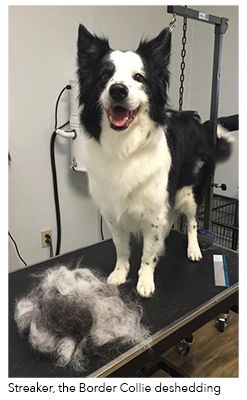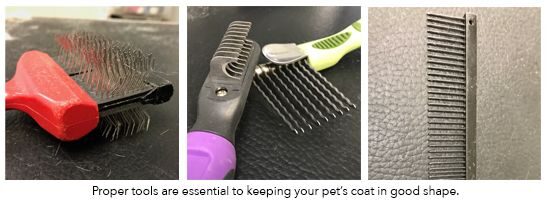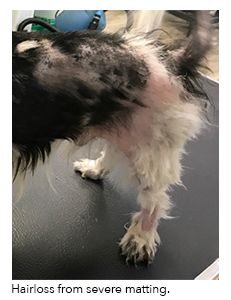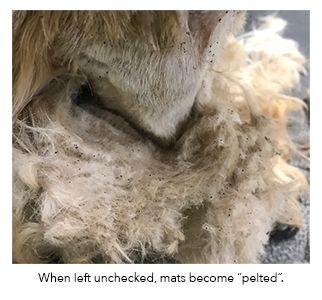
Yes, even yorkies. Yes, even poodles. And yes, even Doodles
Shedding is a natural part of the life cycle of your dog’s hair. Now, some dogs do shed more than others - they don’t call them “German Shedders” for no reason - but no matter the texture…all dogs shed.
Brushing is the best solution to shedding - even for the “non-shedding” dogs. There are some helpful grooming tools which help remove the undercoat from heavily shedding breeds like Shepherds and Huskies. It’s satisfying (if a little bit annoying) to pull clumps of hair out of your dog’s coat during shedding season.
A thorough brushing and de-shedding of a double-coated dog will get their coats ready for the summer. That outer coat, believe it or not, actually protects your dog from the sun and heat - but only if the dense undercoat has been removed.
So what kind of tools do you need for non-shedding dogs?
If you have a "non-shedding" breed of dog, your choice of brush is even more important. Most pet owners are really good at brushing the mantle of the hair - the outer layer. But in order to keep your pet’s coat in the best shape, you need to make sure you’re brushing down to the skin. Pin brushes are good, but you need to make sure you have a good quality slicker brush and a metal comb.
You will also need plenty of patience, treats, and an iron resolve. Teaching your dog to accept brushing is a task in and of itself. Unless you plan on having your dog bathed/groomed weekly by professionals or keeping their hair short - it’s a necessary evil.


Why is brushing that important if they are considered non-shedding?
Somewhere along the way, “non-shedding” began to mean “no brushing” to pet owners, but it’s the “non-shedding” or “hypo-allergenic” breeds that require the MOST brushing and grooming!
If you don’t brush your (poodle, doodle, bichon, shih tzu, maltese, yorkie, coton, schnauzer, westie, the list goes on…) daily/several times a week, your “non-shedding” dog’s hair will continue its life cycle. Dead hair will fall out, but instead of floating around your house, it will become tangled with its neighbors.
Over days/weeks, more of its buddies will join in and a small tangle will morph into something called a mat. Smaller mats join forces into bigger mats that cover larger and larger sections of the body, sometimes forming a solid “casing” or pelt.
Matting is *painful* for the dog because it is pulling the skin tight. Mats that are close to the skin can cause sores due to restricted blood and air flow and trapping moisture, and hair-loss from lack of circulation and, in extreme cases, mold from restricted air flow.
If they’ve been there for some time, removing mats causes its own set of problems. Blood rushing back to the surface of the skin as circulation improves means tingling/itching skin. Mat removal haircuts often mean scratching and biting at the newly recovered skin, which then results in abrasions and hot spots.
Removing mats is a delicate and time-consuming process. Brushing them out - even with special tools - means repeatedly tugging on already-sensitive skin. Using scissors or thinning shears is dangerous because skin can be pulled *into* the mat and skin can be easily sliced.
Removing mats with a clipper is easier but still delicate work. The hair must be cut short enough to go *under* the mats resulting in the “shaved” look most people want to avoid. Clipping so close to the skin can cause irritation and clipper burn, even with the most skilled groomer.

That said - things happen!
Sometimes brushing gets away from you and you get behind and your pup ends up matted. If it’s not too bad maybe they can be brushed out, however, listen to your groomer!
I promise they are not being “lazy” when they tell you your dog can’t be brushed out. They are the ones who have to inflict the discomfort and sometimes downright pain- and believe me they do NOT want to hurt your dog!
If your groomer recommends a shave down and to start over, it’s because the health and comfort of your dog are most important and that’s the safest course of action. Hair will grow back and faster than you might even realize.
Take the new “smooth” or "shaved down" haircut as an opportunity to start fresh - it’s easier to maintain and you can work on your dog’s discipline for brushing. Because they aren’t in pain all over, they will likely be more amenable to being brushed and maybe can learn to even enjoy it when they’re not being pulled on all the time.
Whether you have a Labrador that leaves hair all over your apartment or a Maltese that seems not to shed at all, it’s very important that you make time for maintenance brushing at least several times a week. A well-maintained skin and coat is an important step to keeping your pet healthy overall.
